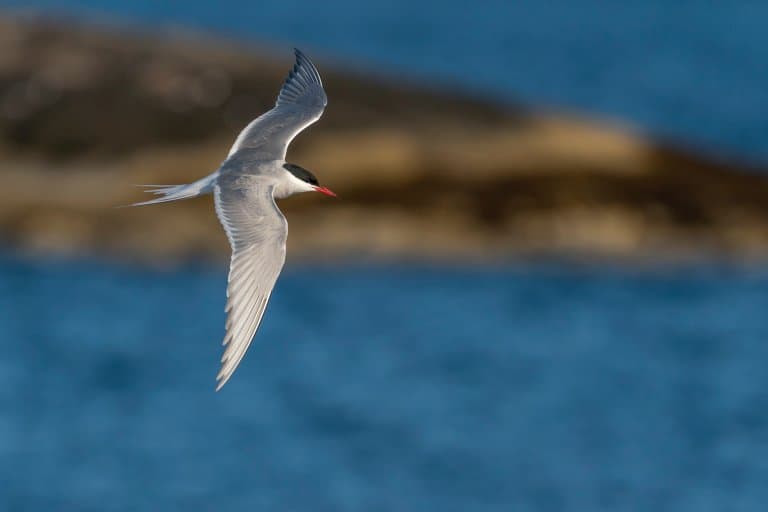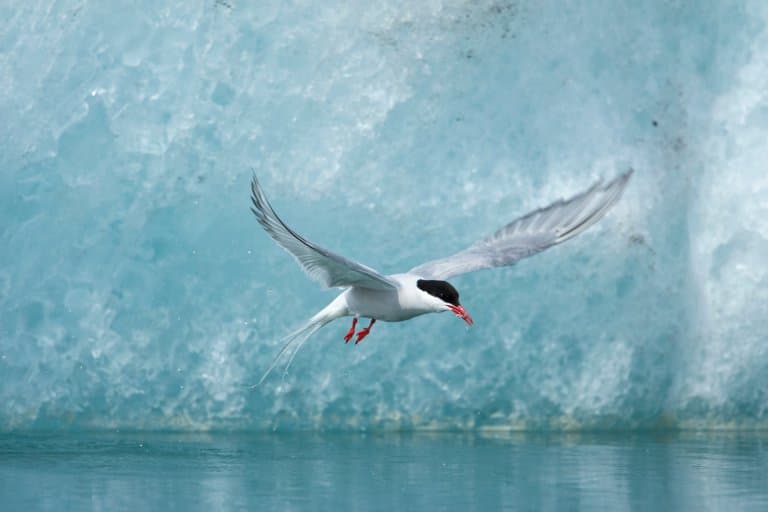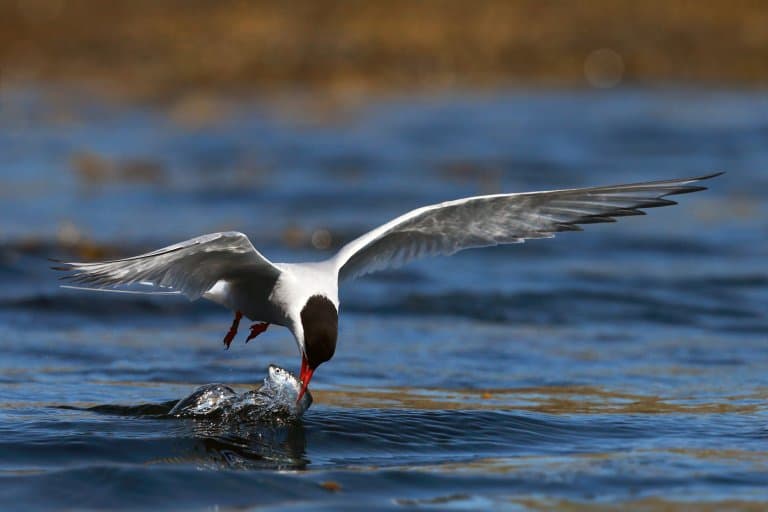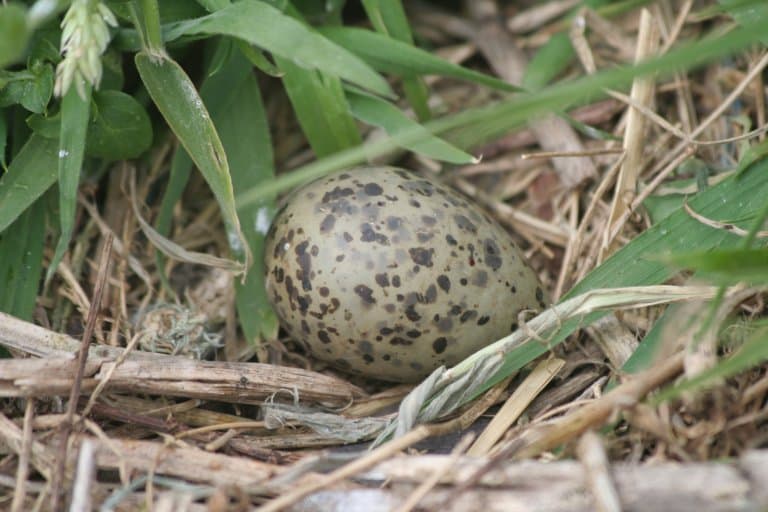Arctic Tern Profile
Bird migrations have been documented for at least 3,000 years, as an impressive feat that captivated curious minds all over the world. Some, like the albatross, fly laterally, circling the pole in the Southern Hemisphere.
Others, like some gulls, will steal your chips all Summer and then disappear South, to warmer regions for the Winter. In the same family, Arctic terns take these migrations to the extreme.
The Arctic tern is a medium-sized tern, which are a family of seabirds and can be found in coastal regions from the north to south poles during migrations.

Arctic Tern Facts Overview
| Habitat: | Polar |
| Location: | Breeding grounds in the Arctic, non-breeding in Antarctica |
| Lifespan: | Can live for several decades, breeding starts at 3-4 years |
| Size: | 33-36 cm (13-14 in) in length |
| Weight: | 86-127 g (3.0-4.5 oz) |
| Colour: | Pale grey plumage, black cap (breeding), red bill and legs |
| Diet: | Fish, marine crustaceans, occasional insects and berries |
| Predators: | Predatory birds, polar bears, foxes, cats, large gulls |
| Top Speed: | 40km/h (25mph) |
| No. of Species: | 1 |
| Conservation Status: | Least Concern by IUCN, but regional threats in some areas |
Arctic terns love summer so much that they never leave it. The only time they experience other seasons is during the 2-month journey to the opposite pole.
They breed in the North, and before the days get too short, they pick up their kids and embark on the longest seasonal migration of any animal.
These trips are navigated using a range of biological navigational tools but are heavily influenced by food availability, something which is ever-changing as the climate shifts, and this may have severe consequences for the species.
Interesting Arctic Tern Facts
1. They rarely see darkness
Terns are well known for their polar migrations that take them from living in the North Pole in the summer, to the South Pole, in the.. summer again.
By avoiding winter, they also avoid the dark, and by moving from one region of perpetual daylight to another, these birds may experience less darkness than any other animal.
The trip takes a couple of months, and this will be the only time the tern experiences regular night times, as they will arrive at their destination to a world of 24-hour sun. 1

2. They’re highly specialised
This epic feat requires significant specialisation, and the tern has it to spare. They’re well adapted for both long flights and the tundra life.
Their slender bodies are designed for agility in hunting; they have long, pointed wings with forked tails for agility, and their light frame conserves energy on long journeys.
This setup allows the birds to spend most of their time in the air, only coming down to breed.
Arctic terns are ground-nesting birds, well adapted to treeless areas in the Arctic, where they fiercely protect their nests. Like many polar animals, their short legs help them conserve heat.
All of these birds are born in the Arctic, but by the time winter threatens, they embark on an unfathomable migration to the most Southerly continent.
3. This is the longest migration known covering 35,000 km
This migration is truly incredible. Each year, Arctic terns embark on a round-trip that can cover more than 35,000 km (22,000 miles), making it the longest migration of any known animal.
Their journey begins in the Arctic, where they breed during the Arctic summer. In late summer, as the temperatures drop and daylight becomes shorter, the terns gather up the new generation and begin the journey south.
They head towards their wintering grounds in the Antarctic region, a trip that takes them over vast expanses of open ocean.
One remarkable aspect of their migration is the use of two alternative routes. Some Arctic terns follow the African coast on their southward journey, while others opt for the South American coast. This bifurcation in migration routes is a curiosity in itself, and scientists are still studying the factors that influence this choice.
Their migration involves multiple stops and destinations along the way. One of the fascinating discoveries in recent years is the identification of a previously unknown stopover area in the North Atlantic Ocean. Arctic terns from different breeding populations, including those from Greenland and Iceland, converge in this region during their migration.
This social stopover area likely serves as a critical refuelling point where birds can rest, replenish their energy reserves, and exchange stories. 2
4. They have magnets in their faces
Bird navigation has long perplexed researchers with its uncanny accuracy and reliability.
Arctic terns exhibit an astonishing ability to navigate from one end of the planet to the other, and it’s not entirely based on visual cues. Navigating these long trips requires a mix of landmarks, celestial cues and magnetism.
Terns can pinpoint their exact breeding and wintering locations year after year, ensuring they return to the same colonies and familiar foraging areas, and they can likely do this with help from a special magnetic compound in their beaks.
Magnetoreception has been demonstrated in several different animal lineages, including various migratory bird species like the Arctic tern.
Iron-rich microstructures have been identified in the beaks of these birds, suggesting the presence of magnetoreceptors: sensory organs that can pick up magnetic fields. This sense combines with the others to produce an arsenal of navigational weapons that give the birds their ability to reach such remote locations accurately, year after year. 3
5. They engage in ‘fish fight’ courtship
Arctic terns primarily feed on fish, which they catch by diving into the water. These are nimble hunters, and despite being equipped for long journeys, are also capable of incredible agility.
This high-fat diet is essential for both their own sustenance and the nourishment of their offspring during the breeding season.
During the breeding season, Arctic terns engage in elaborate courtship rituals that include the male offering fish as a gift to the female. This “fish flight” is a notable aspect of their courtship, and signifies fitness by proving the male to be an adept hunter.
Arctic terns are monogamous and typically mate for life, forming strong pair bonds. They return to the same colony in the Arctic every year, where they build nests together in small depressions in the ground.
Both parents take turns incubating 1 to 3 eggs and the chicks hatch after approximately three to four weeks. Parents continue to catch fish, gradually increasing the size of prey to help their chicks learn to feed themselves as they grow.
Older terns have fewer young, but as they grow, they become more experienced parents, so the young that they have survive more often.
After breeding, terns will rarely touch the ground again until the next season. 4 5

6. They will steal food off other birds
While Artic terms typically hunt for their own food, they can – despite their small size – sometimes engage in stealing food from other birds.
This is known as kleptoparasitism, and they will swoop at birds to startle them, causing them to release their catch.
7. Climate change might be screwing with this migration
Climate change can have a significant impact on the dispersal patterns of Arctic terns; the long-term patterns of breeding dispersal in these birds are influenced by climate conditions, and so subject as these conditions develop.
At both ends of the planet, climate plays a role in determining the distances over which these birds disperse, and as temperatures and weather patterns change, so does food availability in these regions. This leads to a disruption in dispersal behaviours, as birds adapt accordingly.
This change can happen very rapidly, and while the implications of this are still to be determined, understanding the process could be the key to the conservation of this species and others that are similarly affected.
8. Now, they have polar bears to contend with
One clear consequence of the warming Arctic is the increased presence of polar bears on the nesting grounds of terns.
Unlike the rocky landmass of Antarctica, the Arctic is mostly just solid water. As sea ice becomes more scarce, polar bears are being confined to the few patches of land that exist, which happens to also be where terns build their breeding colonies.
A few tern eggs and hatchlings for breakfast could keep a polar bear going for a little while until they find something more substantial, but terns are ferocious parents and are more than capable of leaving the bears with a bloody nose and a disinclination to come back.
Staying true to the family reputation, terns, like gulls, are a handful for anyone to deal with.

9. For now, their population size is healthy
Despite some of the concerns about climate change and food sources, the Arctic tern is classified as ‘least concern’ by the IUCN.
Although their total population size is considered to be decreasing, it’s still estimated at more than two million individuals.
Arctic Tern Fact-File Summary
Scientific Classification
| Kingdom: | Animalia |
| Phylum: | Chordata |
| Class: | Aves |
| Order: | Charadriiformes |
| Family: | Laridae |
| Genus: | Sterna |
| Species: | Sterna Paradisaea |
Fact Sources & References
- “The Endless Summer of the Arctic Tern”, Neshaminy School District.
- Carsten Egevang (2010), “Tracking of Arctic terns Sterna paradisaea reveals longest animal migration, PNAS.
- R. Wiltschko (2012), “The magnetite-based receptors in the beak of birds and their role in avian navigation”, NIH.
- “Arctic Tern”, Ocean Wide Expeditions.
- J. C. COULSON (1975), “The influence of age on the breeding biology and survival of the Arctic tern Sterna paradisaea”, Sci Hub.
